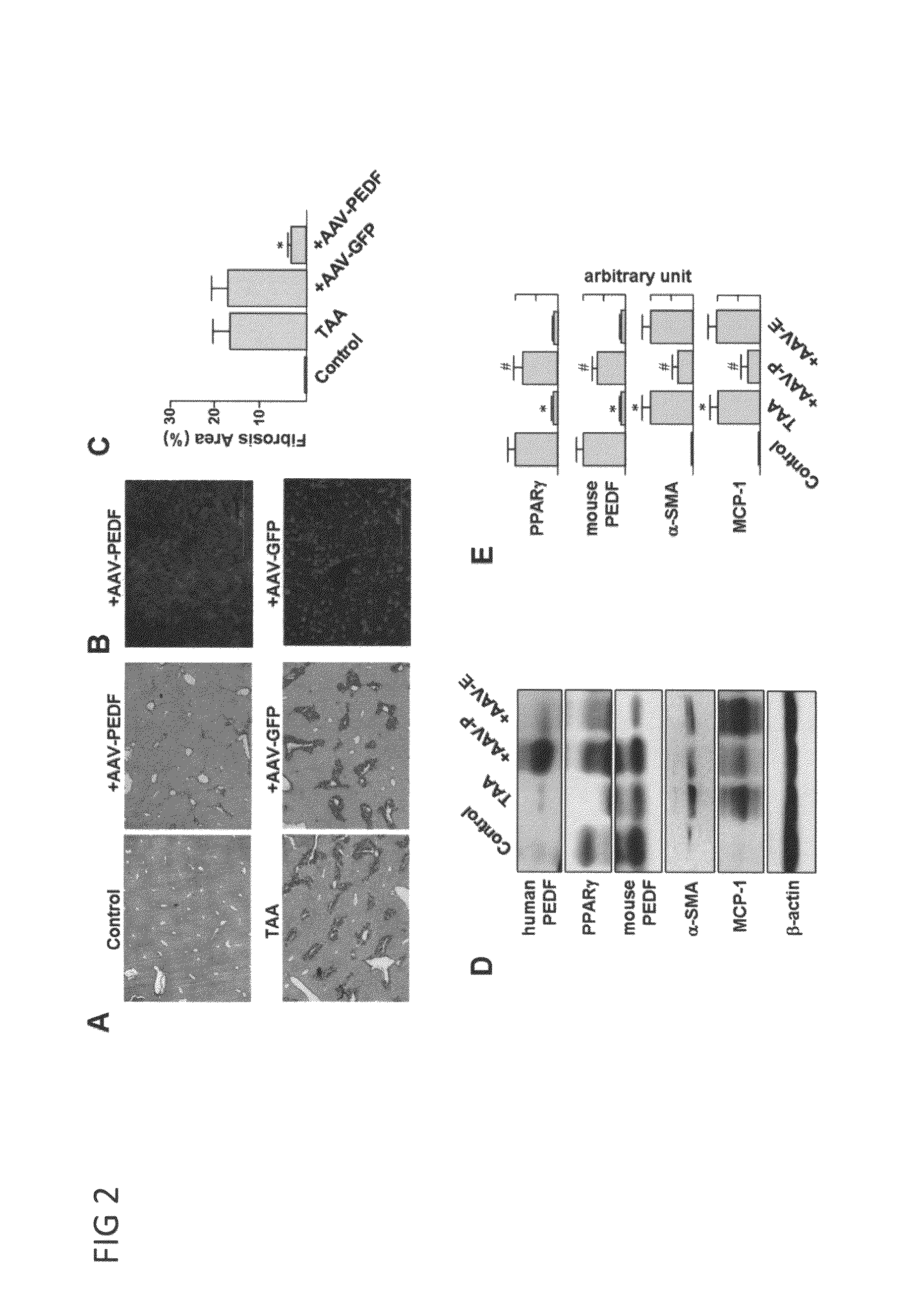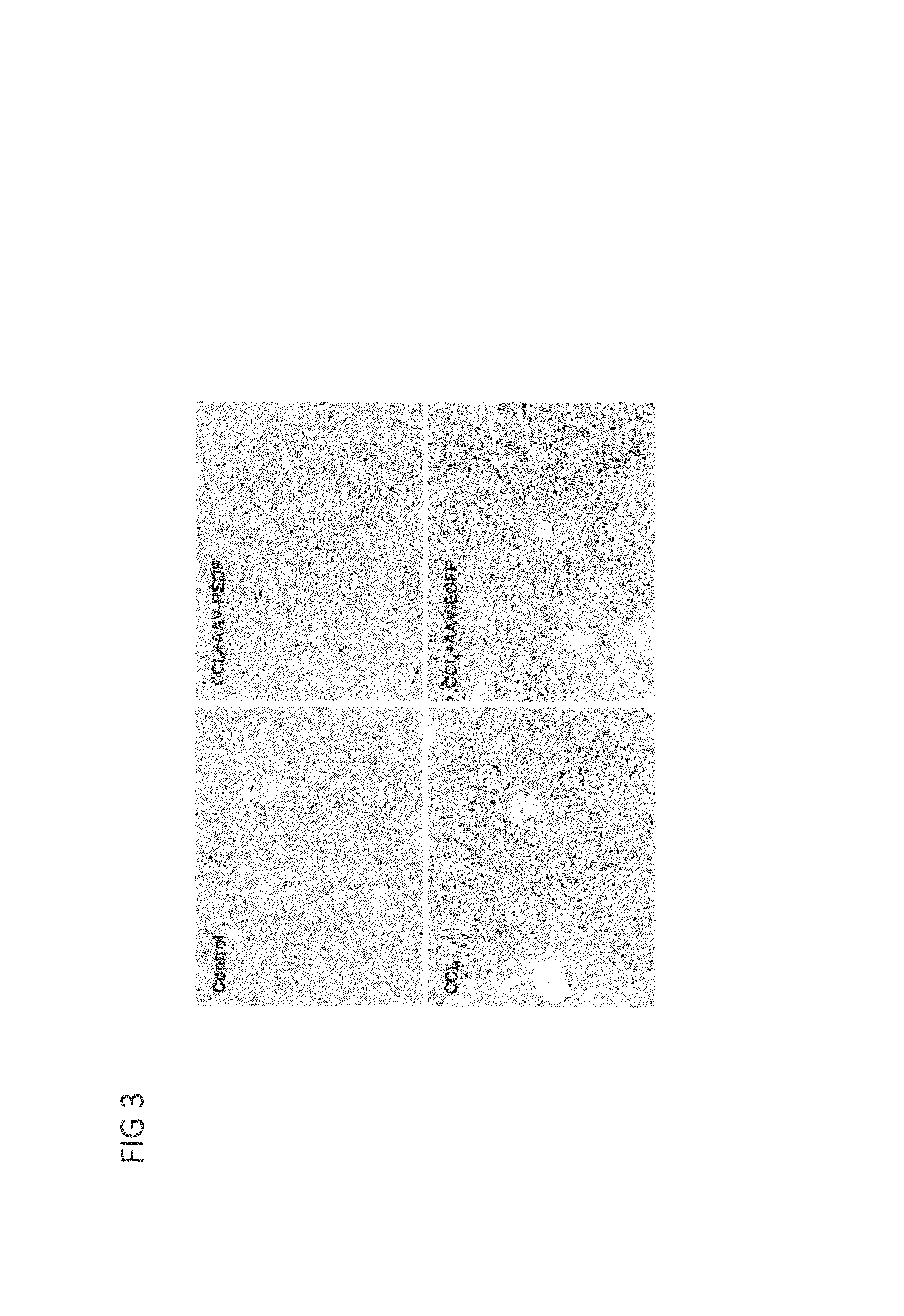Use of PEDF-derived polypeptides for treating liver cirrhosis
a technology of liver cirrhosis and polypeptides, which is applied in the field of liver disease, can solve the problems of suppressing normal hepatocyte regeneration, and achieve the effects of suppressing hepatic fibrosis, promoting liver regeneration, and enhancing replication or self-renewal activity
- Summary
- Abstract
- Description
- Claims
- Application Information
AI Technical Summary
Benefits of technology
Problems solved by technology
Method used
Image
Examples
example 1
PEDF is an Intrinsic Antifibrosis Factor Targeting Hepatic Stellate Cells
1.1 PEDF Prevents CCl4— and Thioacetamide-induced Hepatic Fibrosis
[0062]To supplement liver with PEDF, human PEDF gene was delivered into liver cells by the constructed AAV-PEDF vector described above in Materials and Methods. The same vector was used to deliver the EGFP gene in control experiments. After intraperitoneal injection of mice with CCl4 twice per week for 3 weeks, Sirius red and hematoxylin-stained liver slices revealed a marked parenchymal injury and bridging fibrosis (FIG. 1A). When mice were injected with AAV-PEDF for 1 week before CCl4 treatment for additional 3 weeks, immunofluorescence staining using an anti-human PEDF antibody revealed that local synthesis of PEDF (green) in hepatocytes was achieved by PEDF gene delivery (FIG. 1B). At the same time, reduced parenchymal injury and smaller areas of fibrosis were observed as compared with animals receiving CCl4 plus AAV-EGFP injection (FIG. 1C; ...
example 2
34-mer and 44-mer PEDF Function Similarly to PEDF by Respectively Inactivating Hepatic Stellate Cells (HSCs) and Enhancing Self-renewal Activity of Liver-derived Progenitor Cells (LDPCs)
2.1 Human 34-mer PEDF Suppresses Activation of Hepatic Stellate Cells
[0070]To verify whether the PEDF-derived peptides, particularly, 34-mer PEDF and 44-mer PEDF, may prevent HSCs from activation, culture-activated primary rat HSCs were treated with 4.5 nM PEDF, 50 nM 44-mer, 50 nM 34-mer or PEDF solvent (20 mM Tris / HCl, pH 7.4, 100 mM NaCl) for 48 hours. Immunoblot analysis revealed that 34-mer PEDF similar to PEDF reduced the expressions of α-SMA, Col1a1, and MCP-1; and enhanced the amounts of PPARγ as compared with solvent treatment alone (FIG. 6A-E). 44-mer PEDF does not possess such effects. Immunofluorescent assay also confirmed that 34-mer PEDF reduced the levels of α-SMA in culture-activated HSCs as compared with 44-mer PEDF treatment (FIG. 6F). Such result is consistent with the finding in E...
PUM
| Property | Measurement | Unit |
|---|---|---|
| body weight | aaaaa | aaaaa |
| body weight | aaaaa | aaaaa |
| temperature | aaaaa | aaaaa |
Abstract
Description
Claims
Application Information
 Login to View More
Login to View More - R&D
- Intellectual Property
- Life Sciences
- Materials
- Tech Scout
- Unparalleled Data Quality
- Higher Quality Content
- 60% Fewer Hallucinations
Browse by: Latest US Patents, China's latest patents, Technical Efficacy Thesaurus, Application Domain, Technology Topic, Popular Technical Reports.
© 2025 PatSnap. All rights reserved.Legal|Privacy policy|Modern Slavery Act Transparency Statement|Sitemap|About US| Contact US: help@patsnap.com



